Overview: Mergers and Acquisitions Affecting Performance
VerifiedAdded on 2023/03/17
|10
|2421
|96
Report
AI Summary
This report provides a comprehensive overview of mergers and acquisitions (M&A), exploring their impact on business performance and shareholder value. It begins with an introduction and background, defining mergers and acquisitions, and outlining the research aims and objectives. The report then delves into a literature review, discussing different types of mergers (horizontal, vertical, congeneric, and conglomerate), and their strategic implications. It examines shareholder value creation through M&A, along with the reasons for merger failures, such as limited owner involvement and inadequate integration processes. The role of funding in M&A success is also analyzed. The research methodology involves a qualitative study using questionnaires to assess the impact of mergers. The expected results suggest a positive effect on shareholder value, contingent on minimizing failure factors and employing a proper financial structure. The conclusion emphasizes the importance of strategic decision-making in M&A to achieve profitable outcomes. The report provides an in-depth analysis of the key aspects of mergers and acquisitions and their effects on financial performance and shareholder value.
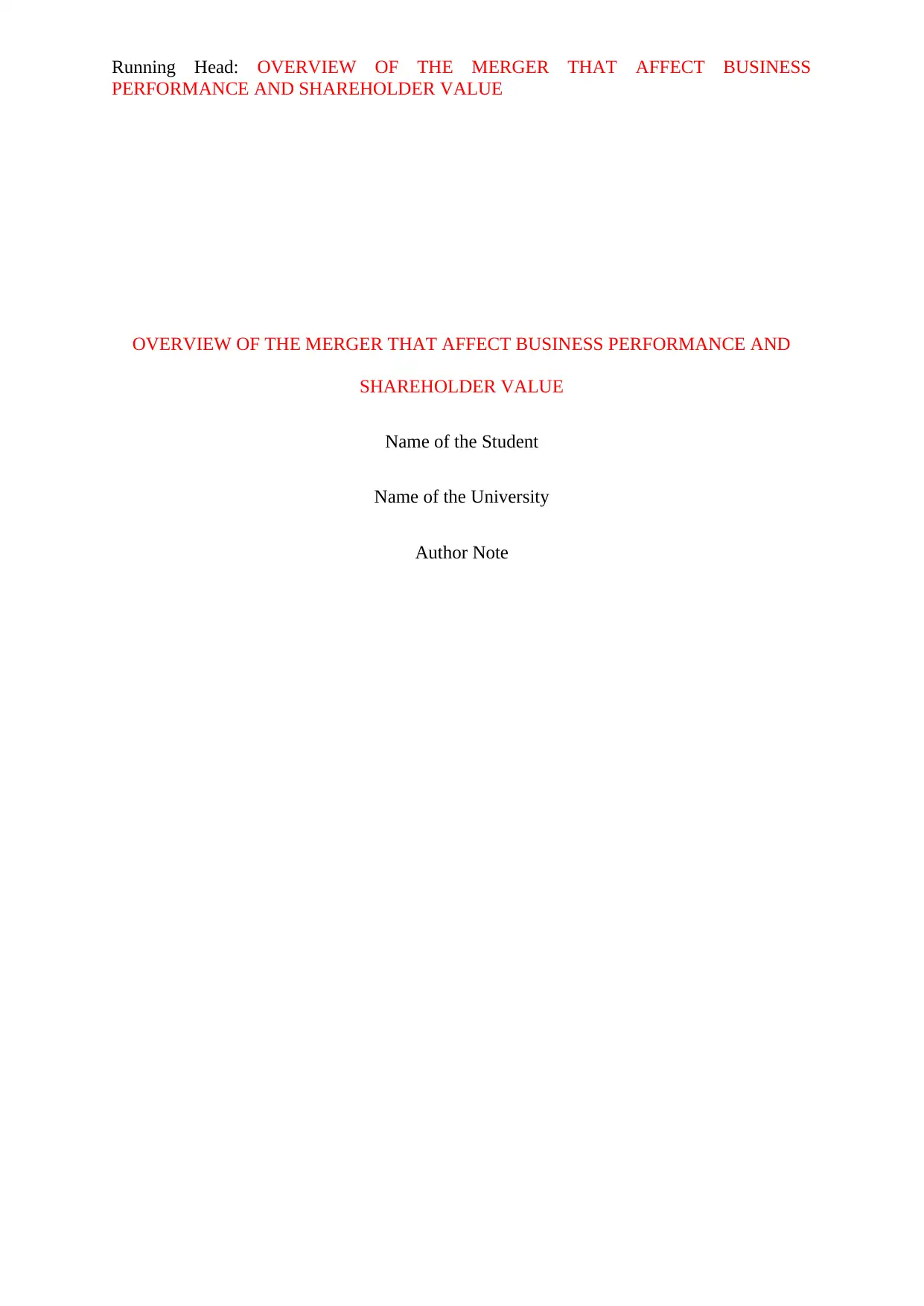
Running Head: OVERVIEW OF THE MERGER THAT AFFECT BUSINESS
PERFORMANCE AND SHAREHOLDER VALUE
OVERVIEW OF THE MERGER THAT AFFECT BUSINESS PERFORMANCE AND
SHAREHOLDER VALUE
Name of the Student
Name of the University
Author Note
PERFORMANCE AND SHAREHOLDER VALUE
OVERVIEW OF THE MERGER THAT AFFECT BUSINESS PERFORMANCE AND
SHAREHOLDER VALUE
Name of the Student
Name of the University
Author Note
Paraphrase This Document
Need a fresh take? Get an instant paraphrase of this document with our AI Paraphraser
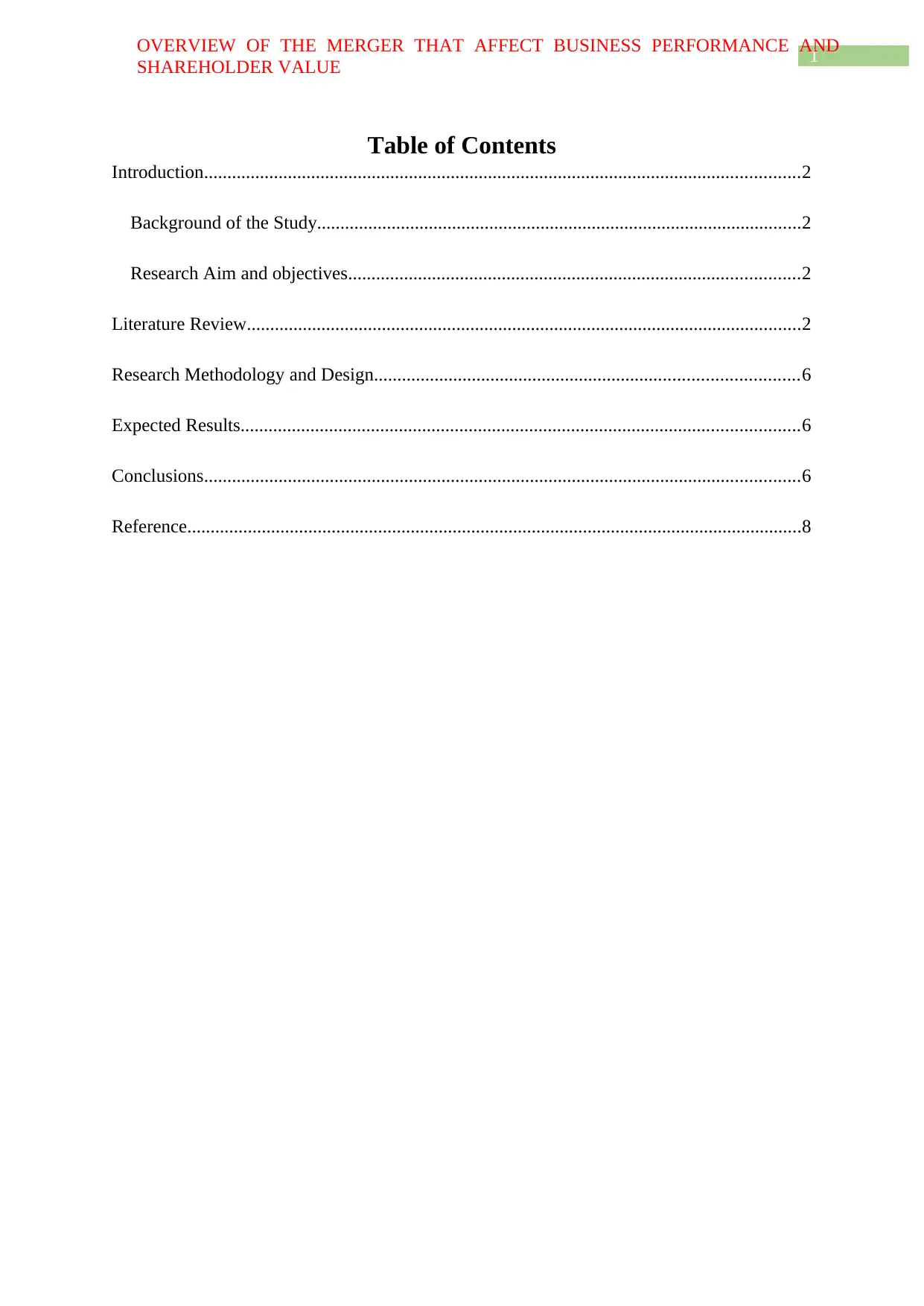
1
OVERVIEW OF THE MERGER THAT AFFECT BUSINESS PERFORMANCE AND
SHAREHOLDER VALUE
Table of Contents
Introduction................................................................................................................................2
Background of the Study........................................................................................................2
Research Aim and objectives.................................................................................................2
Literature Review.......................................................................................................................2
Research Methodology and Design...........................................................................................6
Expected Results........................................................................................................................6
Conclusions................................................................................................................................6
Reference....................................................................................................................................8
OVERVIEW OF THE MERGER THAT AFFECT BUSINESS PERFORMANCE AND
SHAREHOLDER VALUE
Table of Contents
Introduction................................................................................................................................2
Background of the Study........................................................................................................2
Research Aim and objectives.................................................................................................2
Literature Review.......................................................................................................................2
Research Methodology and Design...........................................................................................6
Expected Results........................................................................................................................6
Conclusions................................................................................................................................6
Reference....................................................................................................................................8
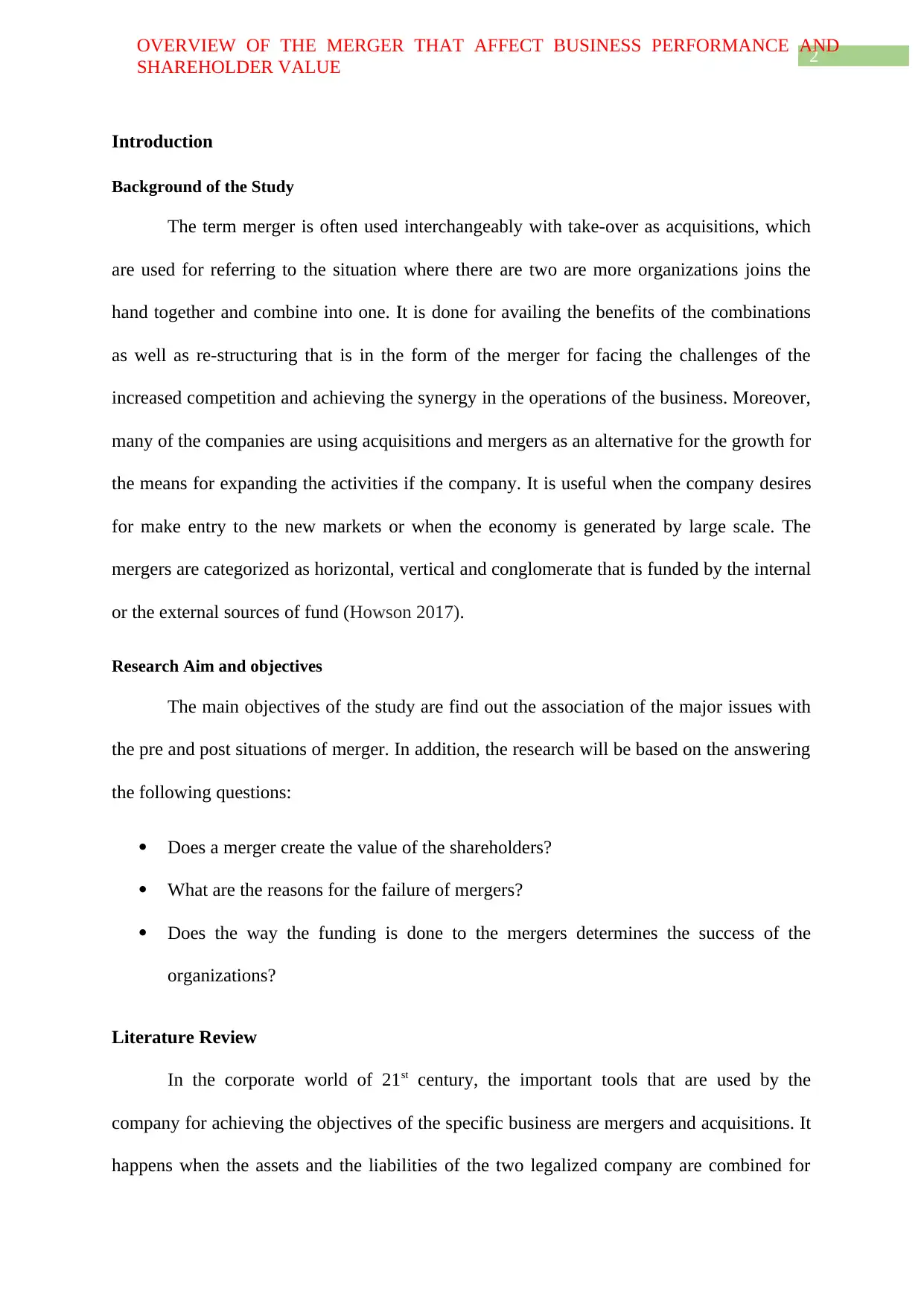
2
OVERVIEW OF THE MERGER THAT AFFECT BUSINESS PERFORMANCE AND
SHAREHOLDER VALUE
Introduction
Background of the Study
The term merger is often used interchangeably with take-over as acquisitions, which
are used for referring to the situation where there are two are more organizations joins the
hand together and combine into one. It is done for availing the benefits of the combinations
as well as re-structuring that is in the form of the merger for facing the challenges of the
increased competition and achieving the synergy in the operations of the business. Moreover,
many of the companies are using acquisitions and mergers as an alternative for the growth for
the means for expanding the activities if the company. It is useful when the company desires
for make entry to the new markets or when the economy is generated by large scale. The
mergers are categorized as horizontal, vertical and conglomerate that is funded by the internal
or the external sources of fund (Howson 2017).
Research Aim and objectives
The main objectives of the study are find out the association of the major issues with
the pre and post situations of merger. In addition, the research will be based on the answering
the following questions:
Does a merger create the value of the shareholders?
What are the reasons for the failure of mergers?
Does the way the funding is done to the mergers determines the success of the
organizations?
Literature Review
In the corporate world of 21st century, the important tools that are used by the
company for achieving the objectives of the specific business are mergers and acquisitions. It
happens when the assets and the liabilities of the two legalized company are combined for
OVERVIEW OF THE MERGER THAT AFFECT BUSINESS PERFORMANCE AND
SHAREHOLDER VALUE
Introduction
Background of the Study
The term merger is often used interchangeably with take-over as acquisitions, which
are used for referring to the situation where there are two are more organizations joins the
hand together and combine into one. It is done for availing the benefits of the combinations
as well as re-structuring that is in the form of the merger for facing the challenges of the
increased competition and achieving the synergy in the operations of the business. Moreover,
many of the companies are using acquisitions and mergers as an alternative for the growth for
the means for expanding the activities if the company. It is useful when the company desires
for make entry to the new markets or when the economy is generated by large scale. The
mergers are categorized as horizontal, vertical and conglomerate that is funded by the internal
or the external sources of fund (Howson 2017).
Research Aim and objectives
The main objectives of the study are find out the association of the major issues with
the pre and post situations of merger. In addition, the research will be based on the answering
the following questions:
Does a merger create the value of the shareholders?
What are the reasons for the failure of mergers?
Does the way the funding is done to the mergers determines the success of the
organizations?
Literature Review
In the corporate world of 21st century, the important tools that are used by the
company for achieving the objectives of the specific business are mergers and acquisitions. It
happens when the assets and the liabilities of the two legalized company are combined for
⊘ This is a preview!⊘
Do you want full access?
Subscribe today to unlock all pages.

Trusted by 1+ million students worldwide
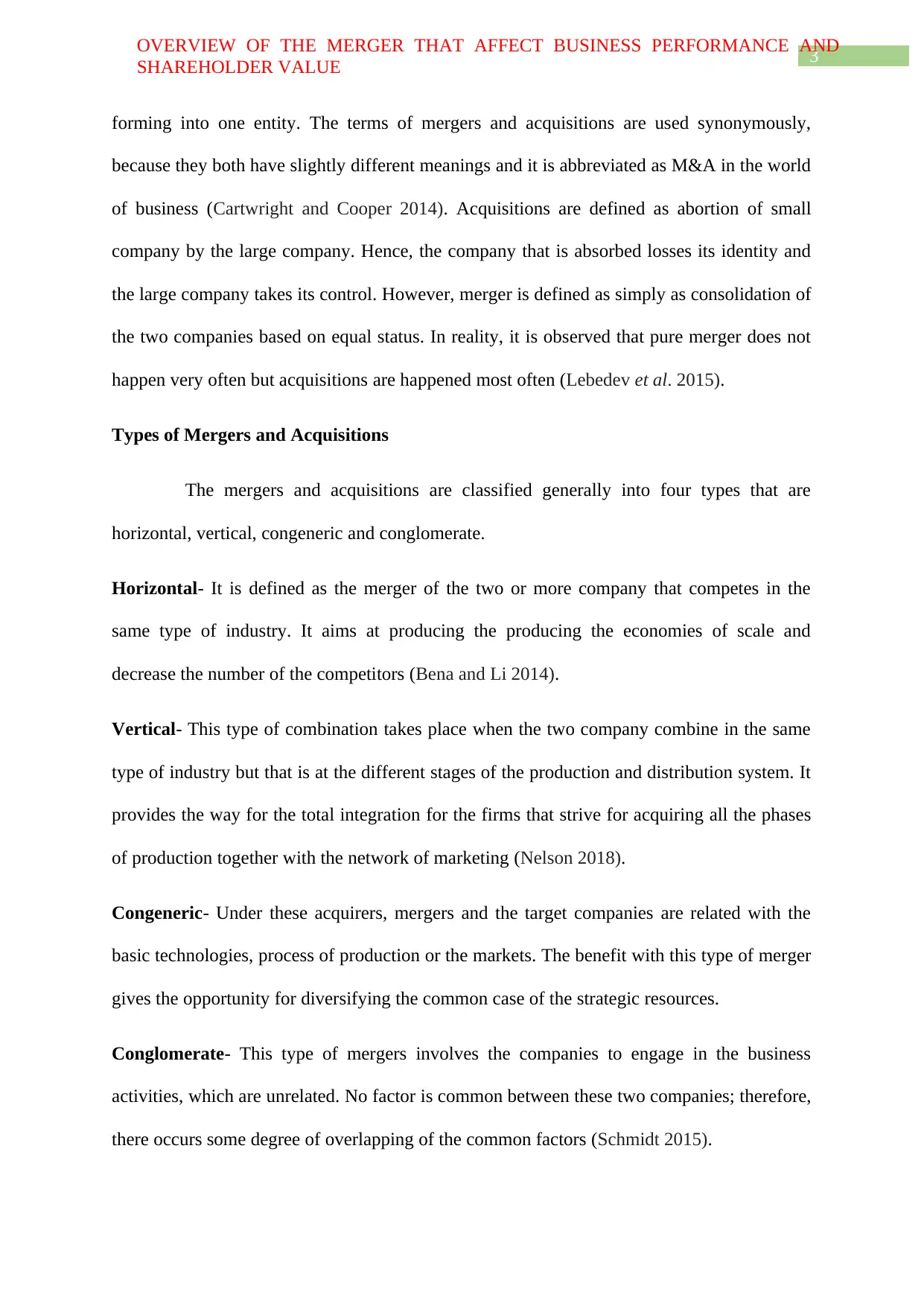
3
OVERVIEW OF THE MERGER THAT AFFECT BUSINESS PERFORMANCE AND
SHAREHOLDER VALUE
forming into one entity. The terms of mergers and acquisitions are used synonymously,
because they both have slightly different meanings and it is abbreviated as M&A in the world
of business (Cartwright and Cooper 2014). Acquisitions are defined as abortion of small
company by the large company. Hence, the company that is absorbed losses its identity and
the large company takes its control. However, merger is defined as simply as consolidation of
the two companies based on equal status. In reality, it is observed that pure merger does not
happen very often but acquisitions are happened most often (Lebedev et al. 2015).
Types of Mergers and Acquisitions
The mergers and acquisitions are classified generally into four types that are
horizontal, vertical, congeneric and conglomerate.
Horizontal- It is defined as the merger of the two or more company that competes in the
same type of industry. It aims at producing the producing the economies of scale and
decrease the number of the competitors (Bena and Li 2014).
Vertical- This type of combination takes place when the two company combine in the same
type of industry but that is at the different stages of the production and distribution system. It
provides the way for the total integration for the firms that strive for acquiring all the phases
of production together with the network of marketing (Nelson 2018).
Congeneric- Under these acquirers, mergers and the target companies are related with the
basic technologies, process of production or the markets. The benefit with this type of merger
gives the opportunity for diversifying the common case of the strategic resources.
Conglomerate- This type of mergers involves the companies to engage in the business
activities, which are unrelated. No factor is common between these two companies; therefore,
there occurs some degree of overlapping of the common factors (Schmidt 2015).
OVERVIEW OF THE MERGER THAT AFFECT BUSINESS PERFORMANCE AND
SHAREHOLDER VALUE
forming into one entity. The terms of mergers and acquisitions are used synonymously,
because they both have slightly different meanings and it is abbreviated as M&A in the world
of business (Cartwright and Cooper 2014). Acquisitions are defined as abortion of small
company by the large company. Hence, the company that is absorbed losses its identity and
the large company takes its control. However, merger is defined as simply as consolidation of
the two companies based on equal status. In reality, it is observed that pure merger does not
happen very often but acquisitions are happened most often (Lebedev et al. 2015).
Types of Mergers and Acquisitions
The mergers and acquisitions are classified generally into four types that are
horizontal, vertical, congeneric and conglomerate.
Horizontal- It is defined as the merger of the two or more company that competes in the
same type of industry. It aims at producing the producing the economies of scale and
decrease the number of the competitors (Bena and Li 2014).
Vertical- This type of combination takes place when the two company combine in the same
type of industry but that is at the different stages of the production and distribution system. It
provides the way for the total integration for the firms that strive for acquiring all the phases
of production together with the network of marketing (Nelson 2018).
Congeneric- Under these acquirers, mergers and the target companies are related with the
basic technologies, process of production or the markets. The benefit with this type of merger
gives the opportunity for diversifying the common case of the strategic resources.
Conglomerate- This type of mergers involves the companies to engage in the business
activities, which are unrelated. No factor is common between these two companies; therefore,
there occurs some degree of overlapping of the common factors (Schmidt 2015).
Paraphrase This Document
Need a fresh take? Get an instant paraphrase of this document with our AI Paraphraser
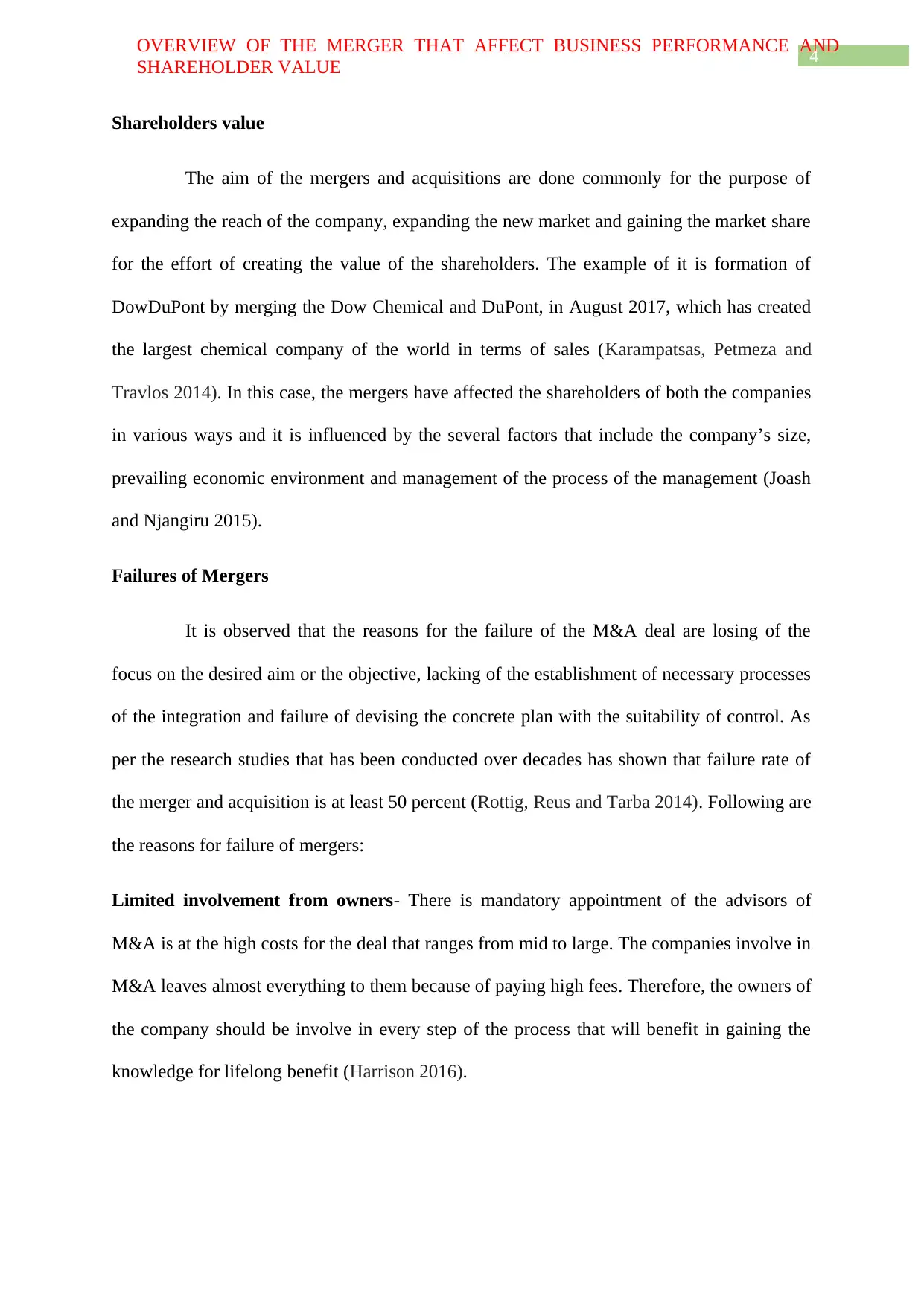
4
OVERVIEW OF THE MERGER THAT AFFECT BUSINESS PERFORMANCE AND
SHAREHOLDER VALUE
Shareholders value
The aim of the mergers and acquisitions are done commonly for the purpose of
expanding the reach of the company, expanding the new market and gaining the market share
for the effort of creating the value of the shareholders. The example of it is formation of
DowDuPont by merging the Dow Chemical and DuPont, in August 2017, which has created
the largest chemical company of the world in terms of sales (Karampatsas, Petmeza and
Travlos 2014). In this case, the mergers have affected the shareholders of both the companies
in various ways and it is influenced by the several factors that include the company’s size,
prevailing economic environment and management of the process of the management (Joash
and Njangiru 2015).
Failures of Mergers
It is observed that the reasons for the failure of the M&A deal are losing of the
focus on the desired aim or the objective, lacking of the establishment of necessary processes
of the integration and failure of devising the concrete plan with the suitability of control. As
per the research studies that has been conducted over decades has shown that failure rate of
the merger and acquisition is at least 50 percent (Rottig, Reus and Tarba 2014). Following are
the reasons for failure of mergers:
Limited involvement from owners- There is mandatory appointment of the advisors of
M&A is at the high costs for the deal that ranges from mid to large. The companies involve in
M&A leaves almost everything to them because of paying high fees. Therefore, the owners of
the company should be involve in every step of the process that will benefit in gaining the
knowledge for lifelong benefit (Harrison 2016).
OVERVIEW OF THE MERGER THAT AFFECT BUSINESS PERFORMANCE AND
SHAREHOLDER VALUE
Shareholders value
The aim of the mergers and acquisitions are done commonly for the purpose of
expanding the reach of the company, expanding the new market and gaining the market share
for the effort of creating the value of the shareholders. The example of it is formation of
DowDuPont by merging the Dow Chemical and DuPont, in August 2017, which has created
the largest chemical company of the world in terms of sales (Karampatsas, Petmeza and
Travlos 2014). In this case, the mergers have affected the shareholders of both the companies
in various ways and it is influenced by the several factors that include the company’s size,
prevailing economic environment and management of the process of the management (Joash
and Njangiru 2015).
Failures of Mergers
It is observed that the reasons for the failure of the M&A deal are losing of the
focus on the desired aim or the objective, lacking of the establishment of necessary processes
of the integration and failure of devising the concrete plan with the suitability of control. As
per the research studies that has been conducted over decades has shown that failure rate of
the merger and acquisition is at least 50 percent (Rottig, Reus and Tarba 2014). Following are
the reasons for failure of mergers:
Limited involvement from owners- There is mandatory appointment of the advisors of
M&A is at the high costs for the deal that ranges from mid to large. The companies involve in
M&A leaves almost everything to them because of paying high fees. Therefore, the owners of
the company should be involve in every step of the process that will benefit in gaining the
knowledge for lifelong benefit (Harrison 2016).
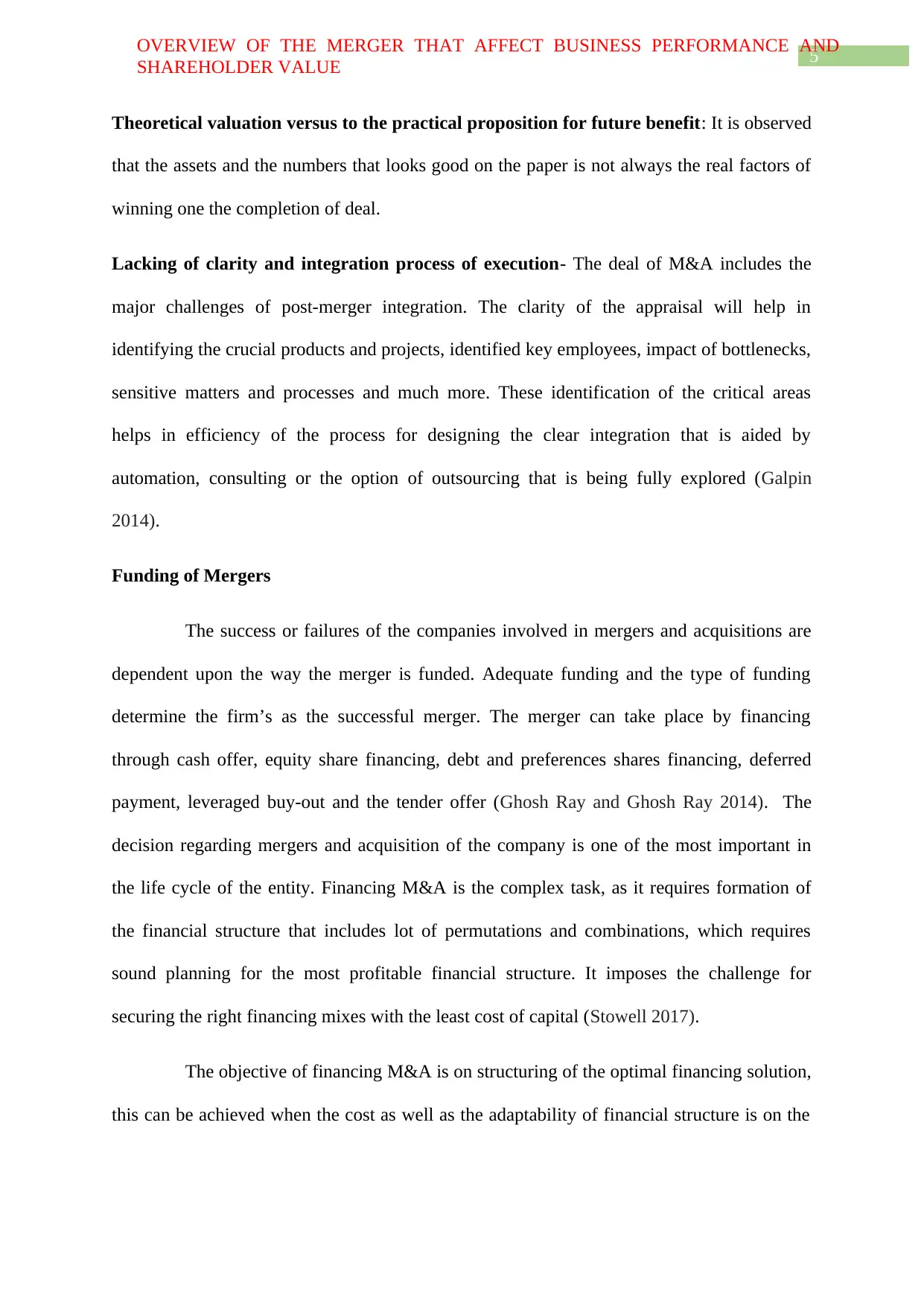
5
OVERVIEW OF THE MERGER THAT AFFECT BUSINESS PERFORMANCE AND
SHAREHOLDER VALUE
Theoretical valuation versus to the practical proposition for future benefit: It is observed
that the assets and the numbers that looks good on the paper is not always the real factors of
winning one the completion of deal.
Lacking of clarity and integration process of execution- The deal of M&A includes the
major challenges of post-merger integration. The clarity of the appraisal will help in
identifying the crucial products and projects, identified key employees, impact of bottlenecks,
sensitive matters and processes and much more. These identification of the critical areas
helps in efficiency of the process for designing the clear integration that is aided by
automation, consulting or the option of outsourcing that is being fully explored (Galpin
2014).
Funding of Mergers
The success or failures of the companies involved in mergers and acquisitions are
dependent upon the way the merger is funded. Adequate funding and the type of funding
determine the firm’s as the successful merger. The merger can take place by financing
through cash offer, equity share financing, debt and preferences shares financing, deferred
payment, leveraged buy-out and the tender offer (Ghosh Ray and Ghosh Ray 2014). The
decision regarding mergers and acquisition of the company is one of the most important in
the life cycle of the entity. Financing M&A is the complex task, as it requires formation of
the financial structure that includes lot of permutations and combinations, which requires
sound planning for the most profitable financial structure. It imposes the challenge for
securing the right financing mixes with the least cost of capital (Stowell 2017).
The objective of financing M&A is on structuring of the optimal financing solution,
this can be achieved when the cost as well as the adaptability of financial structure is on the
OVERVIEW OF THE MERGER THAT AFFECT BUSINESS PERFORMANCE AND
SHAREHOLDER VALUE
Theoretical valuation versus to the practical proposition for future benefit: It is observed
that the assets and the numbers that looks good on the paper is not always the real factors of
winning one the completion of deal.
Lacking of clarity and integration process of execution- The deal of M&A includes the
major challenges of post-merger integration. The clarity of the appraisal will help in
identifying the crucial products and projects, identified key employees, impact of bottlenecks,
sensitive matters and processes and much more. These identification of the critical areas
helps in efficiency of the process for designing the clear integration that is aided by
automation, consulting or the option of outsourcing that is being fully explored (Galpin
2014).
Funding of Mergers
The success or failures of the companies involved in mergers and acquisitions are
dependent upon the way the merger is funded. Adequate funding and the type of funding
determine the firm’s as the successful merger. The merger can take place by financing
through cash offer, equity share financing, debt and preferences shares financing, deferred
payment, leveraged buy-out and the tender offer (Ghosh Ray and Ghosh Ray 2014). The
decision regarding mergers and acquisition of the company is one of the most important in
the life cycle of the entity. Financing M&A is the complex task, as it requires formation of
the financial structure that includes lot of permutations and combinations, which requires
sound planning for the most profitable financial structure. It imposes the challenge for
securing the right financing mixes with the least cost of capital (Stowell 2017).
The objective of financing M&A is on structuring of the optimal financing solution,
this can be achieved when the cost as well as the adaptability of financial structure is on the
⊘ This is a preview!⊘
Do you want full access?
Subscribe today to unlock all pages.

Trusted by 1+ million students worldwide
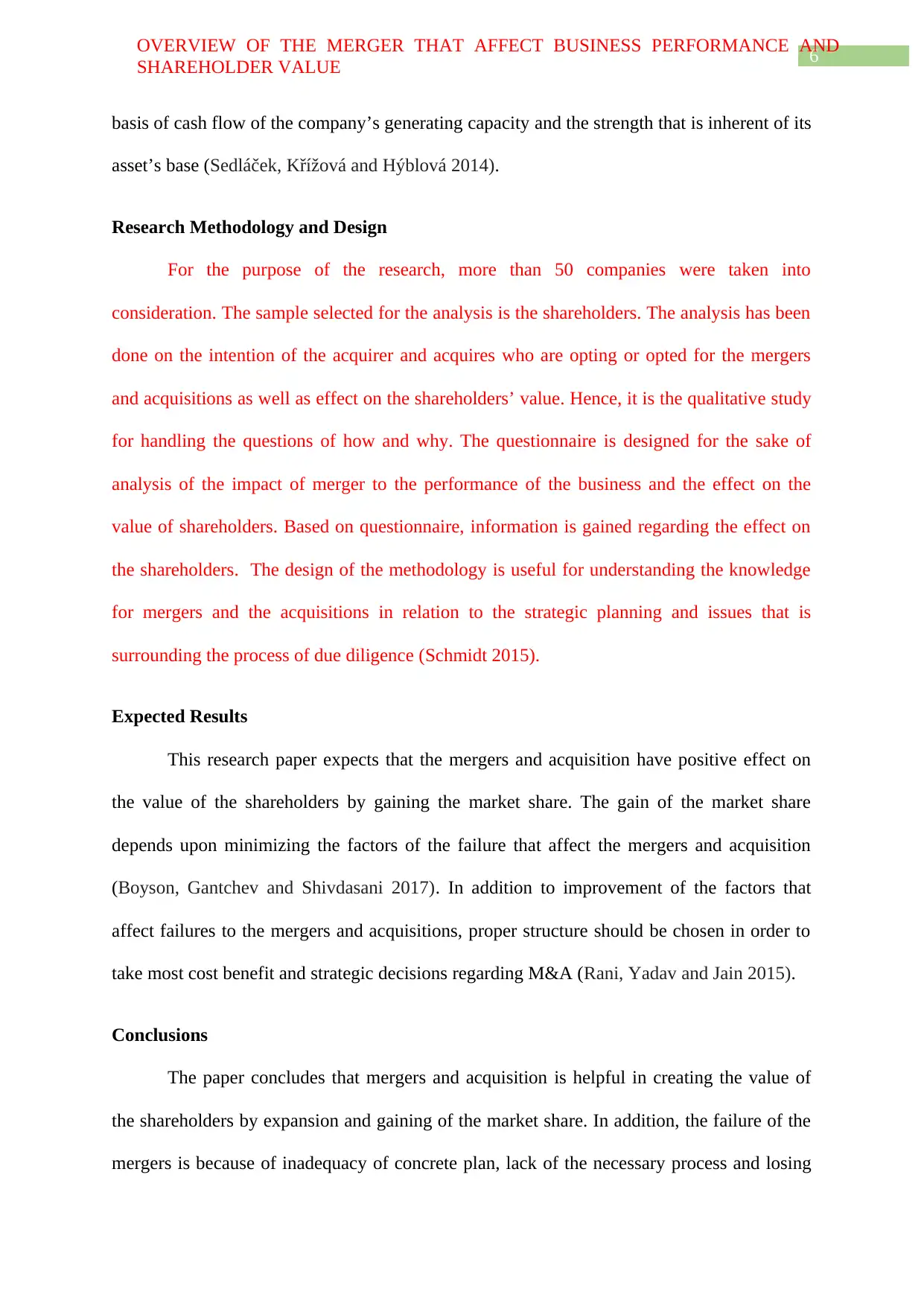
6
OVERVIEW OF THE MERGER THAT AFFECT BUSINESS PERFORMANCE AND
SHAREHOLDER VALUE
basis of cash flow of the company’s generating capacity and the strength that is inherent of its
asset’s base (Sedláček, Křížová and Hýblová 2014).
Research Methodology and Design
For the purpose of the research, more than 50 companies were taken into
consideration. The sample selected for the analysis is the shareholders. The analysis has been
done on the intention of the acquirer and acquires who are opting or opted for the mergers
and acquisitions as well as effect on the shareholders’ value. Hence, it is the qualitative study
for handling the questions of how and why. The questionnaire is designed for the sake of
analysis of the impact of merger to the performance of the business and the effect on the
value of shareholders. Based on questionnaire, information is gained regarding the effect on
the shareholders. The design of the methodology is useful for understanding the knowledge
for mergers and the acquisitions in relation to the strategic planning and issues that is
surrounding the process of due diligence (Schmidt 2015).
Expected Results
This research paper expects that the mergers and acquisition have positive effect on
the value of the shareholders by gaining the market share. The gain of the market share
depends upon minimizing the factors of the failure that affect the mergers and acquisition
(Boyson, Gantchev and Shivdasani 2017). In addition to improvement of the factors that
affect failures to the mergers and acquisitions, proper structure should be chosen in order to
take most cost benefit and strategic decisions regarding M&A (Rani, Yadav and Jain 2015).
Conclusions
The paper concludes that mergers and acquisition is helpful in creating the value of
the shareholders by expansion and gaining of the market share. In addition, the failure of the
mergers is because of inadequacy of concrete plan, lack of the necessary process and losing
OVERVIEW OF THE MERGER THAT AFFECT BUSINESS PERFORMANCE AND
SHAREHOLDER VALUE
basis of cash flow of the company’s generating capacity and the strength that is inherent of its
asset’s base (Sedláček, Křížová and Hýblová 2014).
Research Methodology and Design
For the purpose of the research, more than 50 companies were taken into
consideration. The sample selected for the analysis is the shareholders. The analysis has been
done on the intention of the acquirer and acquires who are opting or opted for the mergers
and acquisitions as well as effect on the shareholders’ value. Hence, it is the qualitative study
for handling the questions of how and why. The questionnaire is designed for the sake of
analysis of the impact of merger to the performance of the business and the effect on the
value of shareholders. Based on questionnaire, information is gained regarding the effect on
the shareholders. The design of the methodology is useful for understanding the knowledge
for mergers and the acquisitions in relation to the strategic planning and issues that is
surrounding the process of due diligence (Schmidt 2015).
Expected Results
This research paper expects that the mergers and acquisition have positive effect on
the value of the shareholders by gaining the market share. The gain of the market share
depends upon minimizing the factors of the failure that affect the mergers and acquisition
(Boyson, Gantchev and Shivdasani 2017). In addition to improvement of the factors that
affect failures to the mergers and acquisitions, proper structure should be chosen in order to
take most cost benefit and strategic decisions regarding M&A (Rani, Yadav and Jain 2015).
Conclusions
The paper concludes that mergers and acquisition is helpful in creating the value of
the shareholders by expansion and gaining of the market share. In addition, the failure of the
mergers is because of inadequacy of concrete plan, lack of the necessary process and losing
Paraphrase This Document
Need a fresh take? Get an instant paraphrase of this document with our AI Paraphraser
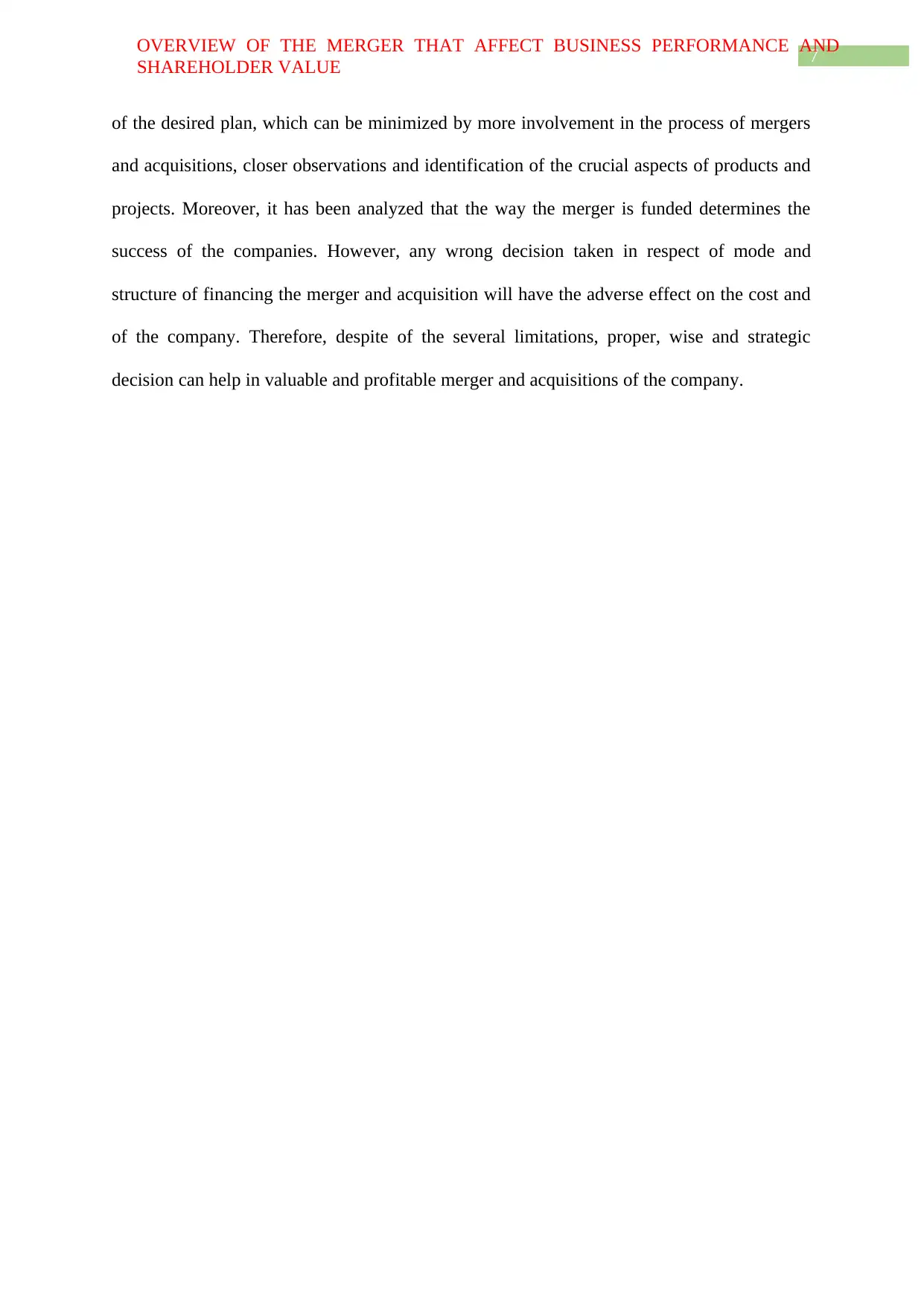
7
OVERVIEW OF THE MERGER THAT AFFECT BUSINESS PERFORMANCE AND
SHAREHOLDER VALUE
of the desired plan, which can be minimized by more involvement in the process of mergers
and acquisitions, closer observations and identification of the crucial aspects of products and
projects. Moreover, it has been analyzed that the way the merger is funded determines the
success of the companies. However, any wrong decision taken in respect of mode and
structure of financing the merger and acquisition will have the adverse effect on the cost and
of the company. Therefore, despite of the several limitations, proper, wise and strategic
decision can help in valuable and profitable merger and acquisitions of the company.
OVERVIEW OF THE MERGER THAT AFFECT BUSINESS PERFORMANCE AND
SHAREHOLDER VALUE
of the desired plan, which can be minimized by more involvement in the process of mergers
and acquisitions, closer observations and identification of the crucial aspects of products and
projects. Moreover, it has been analyzed that the way the merger is funded determines the
success of the companies. However, any wrong decision taken in respect of mode and
structure of financing the merger and acquisition will have the adverse effect on the cost and
of the company. Therefore, despite of the several limitations, proper, wise and strategic
decision can help in valuable and profitable merger and acquisitions of the company.
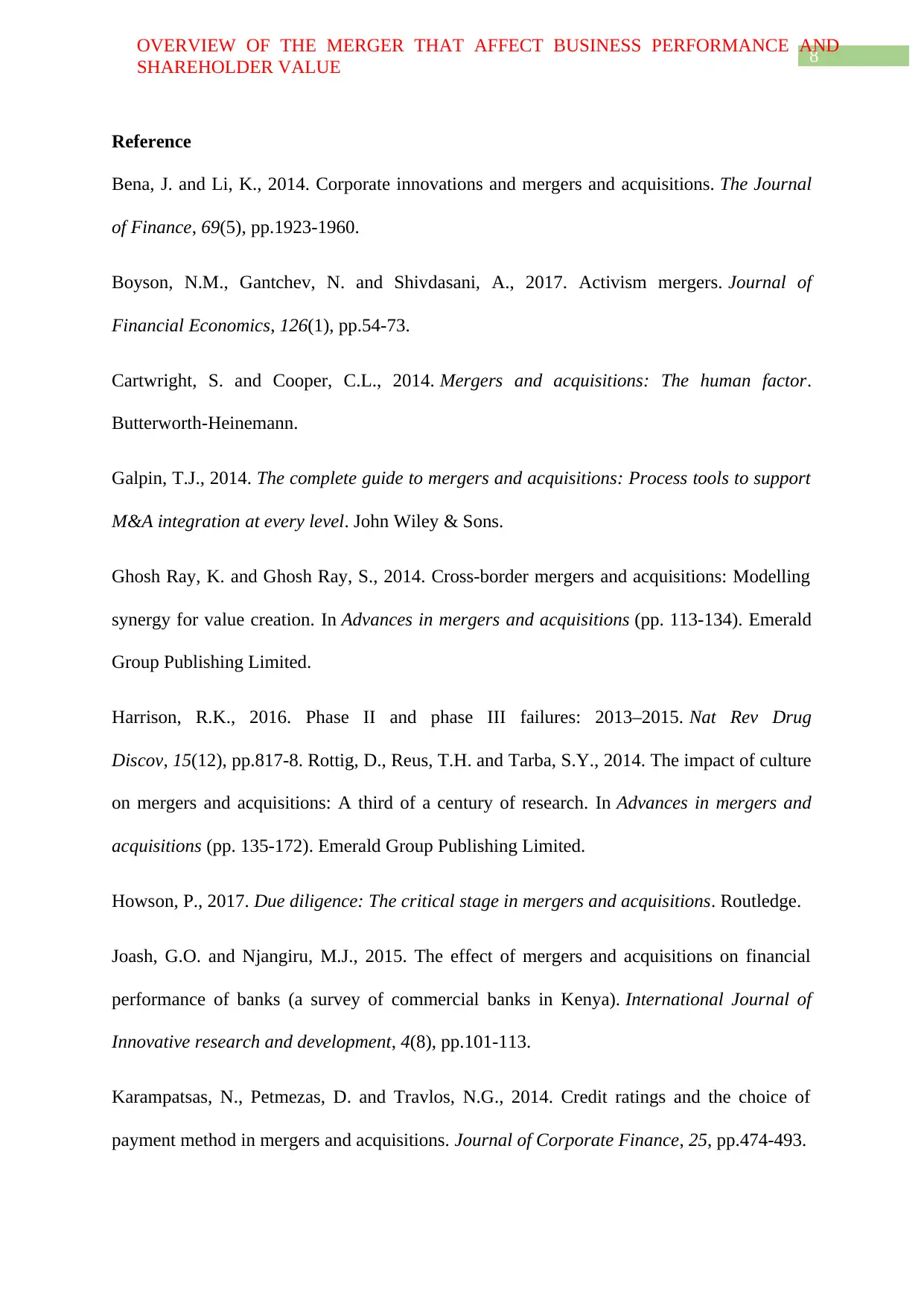
8
OVERVIEW OF THE MERGER THAT AFFECT BUSINESS PERFORMANCE AND
SHAREHOLDER VALUE
Reference
Bena, J. and Li, K., 2014. Corporate innovations and mergers and acquisitions. The Journal
of Finance, 69(5), pp.1923-1960.
Boyson, N.M., Gantchev, N. and Shivdasani, A., 2017. Activism mergers. Journal of
Financial Economics, 126(1), pp.54-73.
Cartwright, S. and Cooper, C.L., 2014. Mergers and acquisitions: The human factor.
Butterworth-Heinemann.
Galpin, T.J., 2014. The complete guide to mergers and acquisitions: Process tools to support
M&A integration at every level. John Wiley & Sons.
Ghosh Ray, K. and Ghosh Ray, S., 2014. Cross-border mergers and acquisitions: Modelling
synergy for value creation. In Advances in mergers and acquisitions (pp. 113-134). Emerald
Group Publishing Limited.
Harrison, R.K., 2016. Phase II and phase III failures: 2013–2015. Nat Rev Drug
Discov, 15(12), pp.817-8. Rottig, D., Reus, T.H. and Tarba, S.Y., 2014. The impact of culture
on mergers and acquisitions: A third of a century of research. In Advances in mergers and
acquisitions (pp. 135-172). Emerald Group Publishing Limited.
Howson, P., 2017. Due diligence: The critical stage in mergers and acquisitions. Routledge.
Joash, G.O. and Njangiru, M.J., 2015. The effect of mergers and acquisitions on financial
performance of banks (a survey of commercial banks in Kenya). International Journal of
Innovative research and development, 4(8), pp.101-113.
Karampatsas, N., Petmezas, D. and Travlos, N.G., 2014. Credit ratings and the choice of
payment method in mergers and acquisitions. Journal of Corporate Finance, 25, pp.474-493.
OVERVIEW OF THE MERGER THAT AFFECT BUSINESS PERFORMANCE AND
SHAREHOLDER VALUE
Reference
Bena, J. and Li, K., 2014. Corporate innovations and mergers and acquisitions. The Journal
of Finance, 69(5), pp.1923-1960.
Boyson, N.M., Gantchev, N. and Shivdasani, A., 2017. Activism mergers. Journal of
Financial Economics, 126(1), pp.54-73.
Cartwright, S. and Cooper, C.L., 2014. Mergers and acquisitions: The human factor.
Butterworth-Heinemann.
Galpin, T.J., 2014. The complete guide to mergers and acquisitions: Process tools to support
M&A integration at every level. John Wiley & Sons.
Ghosh Ray, K. and Ghosh Ray, S., 2014. Cross-border mergers and acquisitions: Modelling
synergy for value creation. In Advances in mergers and acquisitions (pp. 113-134). Emerald
Group Publishing Limited.
Harrison, R.K., 2016. Phase II and phase III failures: 2013–2015. Nat Rev Drug
Discov, 15(12), pp.817-8. Rottig, D., Reus, T.H. and Tarba, S.Y., 2014. The impact of culture
on mergers and acquisitions: A third of a century of research. In Advances in mergers and
acquisitions (pp. 135-172). Emerald Group Publishing Limited.
Howson, P., 2017. Due diligence: The critical stage in mergers and acquisitions. Routledge.
Joash, G.O. and Njangiru, M.J., 2015. The effect of mergers and acquisitions on financial
performance of banks (a survey of commercial banks in Kenya). International Journal of
Innovative research and development, 4(8), pp.101-113.
Karampatsas, N., Petmezas, D. and Travlos, N.G., 2014. Credit ratings and the choice of
payment method in mergers and acquisitions. Journal of Corporate Finance, 25, pp.474-493.
⊘ This is a preview!⊘
Do you want full access?
Subscribe today to unlock all pages.

Trusted by 1+ million students worldwide
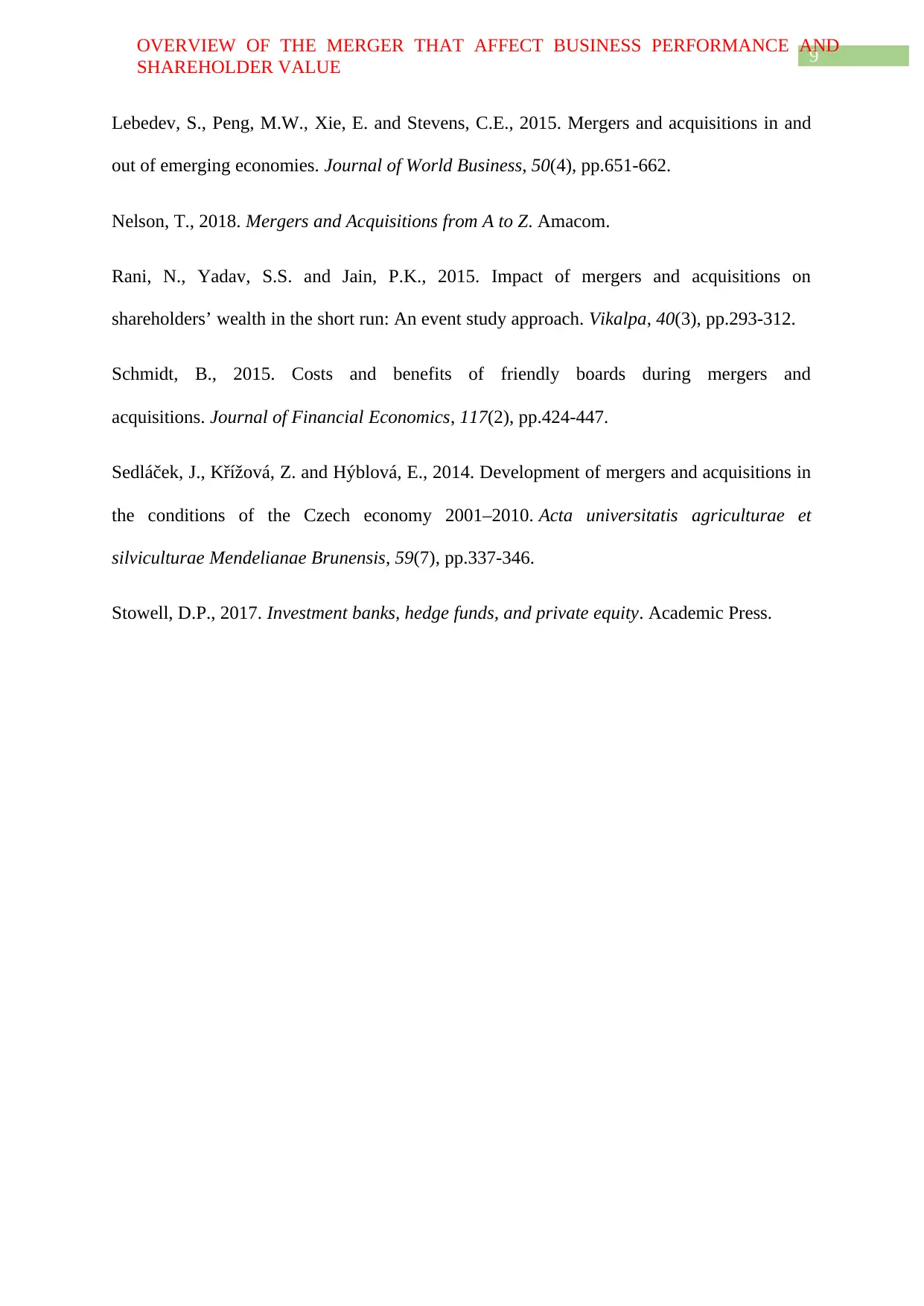
9
OVERVIEW OF THE MERGER THAT AFFECT BUSINESS PERFORMANCE AND
SHAREHOLDER VALUE
Lebedev, S., Peng, M.W., Xie, E. and Stevens, C.E., 2015. Mergers and acquisitions in and
out of emerging economies. Journal of World Business, 50(4), pp.651-662.
Nelson, T., 2018. Mergers and Acquisitions from A to Z. Amacom.
Rani, N., Yadav, S.S. and Jain, P.K., 2015. Impact of mergers and acquisitions on
shareholders’ wealth in the short run: An event study approach. Vikalpa, 40(3), pp.293-312.
Schmidt, B., 2015. Costs and benefits of friendly boards during mergers and
acquisitions. Journal of Financial Economics, 117(2), pp.424-447.
Sedláček, J., Křížová, Z. and Hýblová, E., 2014. Development of mergers and acquisitions in
the conditions of the Czech economy 2001–2010. Acta universitatis agriculturae et
silviculturae Mendelianae Brunensis, 59(7), pp.337-346.
Stowell, D.P., 2017. Investment banks, hedge funds, and private equity. Academic Press.
OVERVIEW OF THE MERGER THAT AFFECT BUSINESS PERFORMANCE AND
SHAREHOLDER VALUE
Lebedev, S., Peng, M.W., Xie, E. and Stevens, C.E., 2015. Mergers and acquisitions in and
out of emerging economies. Journal of World Business, 50(4), pp.651-662.
Nelson, T., 2018. Mergers and Acquisitions from A to Z. Amacom.
Rani, N., Yadav, S.S. and Jain, P.K., 2015. Impact of mergers and acquisitions on
shareholders’ wealth in the short run: An event study approach. Vikalpa, 40(3), pp.293-312.
Schmidt, B., 2015. Costs and benefits of friendly boards during mergers and
acquisitions. Journal of Financial Economics, 117(2), pp.424-447.
Sedláček, J., Křížová, Z. and Hýblová, E., 2014. Development of mergers and acquisitions in
the conditions of the Czech economy 2001–2010. Acta universitatis agriculturae et
silviculturae Mendelianae Brunensis, 59(7), pp.337-346.
Stowell, D.P., 2017. Investment banks, hedge funds, and private equity. Academic Press.
1 out of 10
Related Documents
Your All-in-One AI-Powered Toolkit for Academic Success.
+13062052269
info@desklib.com
Available 24*7 on WhatsApp / Email
![[object Object]](/_next/static/media/star-bottom.7253800d.svg)
Unlock your academic potential
Copyright © 2020–2025 A2Z Services. All Rights Reserved. Developed and managed by ZUCOL.





